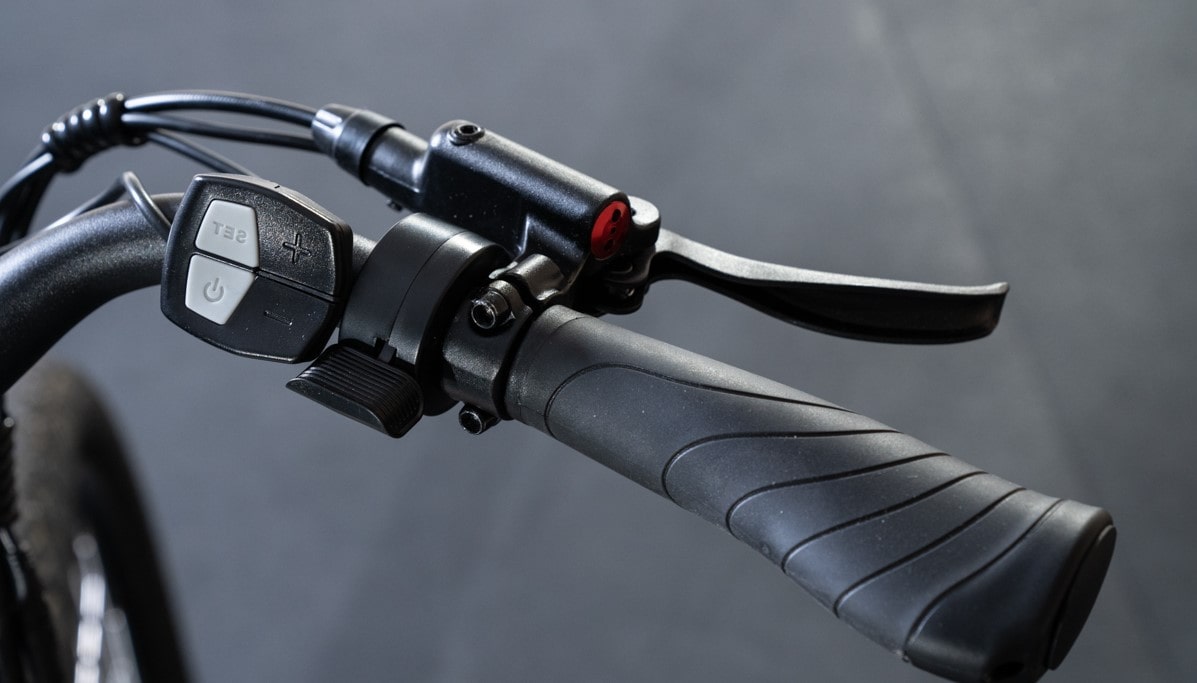Throttle control on E-Bikes
Throttle control is a popular feature on many electric bikes, offering riders the ability to control the motor's power output without pedaling. While pedal-assist systems have become increasingly common, throttle control remains a valuable option for those seeking a more motorcycle-like riding experience or additional assistance when needed. This article will explore the benefits and drawbacks of throttle control on e-bikes, as well as its legal status and how it compares to pedal-assist systems.
Short answer: Throttle control on e-bikes allows riders to activate the motor and control its power output without pedaling, providing a more motorcycle-like riding experience. While throttle control can be useful for getting a quick burst of speed or navigating challenging terrain, it may also have some drawbacks in terms of efficiency and legal restrictions. Understanding the pros and cons of throttle control, as well as the laws governing its use, can help riders make informed decisions about their e-bike setup.
- What is Throttle Control?
- Types of Throttle Controls
- Benefits of Throttle Control
- Drawbacks of Throttle Control
- Throttle Control vs. Pedal-Assist
- Legal Status of Throttle Control
- Choosing the Right E-Bike Setup
- Throttle Control FAQ
What is Throttle Control?

Throttle control is a feature found on some electric bikes that allows the rider to control the motor's power output directly, without the need to pedal. Similar to the throttle on a motorcycle, an e-bike throttle is usually activated by twisting a grip or pressing a button on the handlebars. When engaged, the throttle sends a signal to the e-bike's controller, which then delivers power to the motor, propelling the bike forward.
Throttle control can be used independently of the e-bike's pedal-assist system, allowing riders to accelerate and maintain speed without pedaling. This can be particularly useful for getting a quick burst of speed when starting from a stop, climbing hills, or navigating challenging terrain. Some e-bikes offer throttle control as an optional feature, while others may have it as the primary means of activating the motor.
Types of Throttle Controls
There are two main types of throttle controls found on e-bikes:
Twist Throttle: A twist throttle is a grip on the handlebars that the rider twists to activate and control the motor. The throttle is spring-loaded, so it returns to its original position when released. The more the rider twists the throttle, the more power is delivered to the motor, allowing for smooth and precise speed control.
Thumb Throttle: A thumb throttle is a small lever or button located near the rider's thumb on the handlebars. To activate the motor, the rider presses down on the throttle with their thumb. Some thumb throttles are variable, allowing the rider to control the motor's power output by applying more or less pressure. Others may have preset power levels that the rider can toggle through.
Benefits of Throttle Control

Throttle control offers several benefits for e-bike riders:
Instant Power: Throttle control allows riders to access the motor's power instantly, without the need to pedal. This can be helpful when starting from a stop, climbing hills, or navigating rough terrain.
Motorcycle-like Experience: For riders who prefer a more motorcycle-like riding experience, throttle control can provide a familiar and intuitive way to control the e-bike's speed and power.
Reduced Physical Strain: Throttle control can be beneficial for riders with limited physical abilities or those who may need a break from pedaling during long rides. The ability to rely solely on the motor can help reduce fatigue and strain on the rider's legs and joints.
Flexibility: E-bikes with throttle control often allow riders to switch between throttle-only mode and pedal-assist mode, providing greater flexibility to adapt to different riding conditions and preferences.
Drawbacks of Throttle Control
While throttle control has its advantages, there are also some potential drawbacks to consider:
Reduced Efficiency: Relying solely on the throttle for propulsion can be less efficient than pedaling with the assistance of the motor. This can lead to reduced range and shorter battery life compared to pedal-assist systems.
Legal Restrictions: In some regions, e-bikes with throttle control may be subject to more stringent legal requirements or restrictions. For example, in the United States, e-bikes with throttle control may be classified as motorized vehicles, requiring licensing, registration, and insurance in certain states.
Safety Concerns: Throttle control can sometimes lead to unintended acceleration if the rider accidentally twists the throttle or presses the button. This can be particularly dangerous for inexperienced riders or in crowded areas.
Limited Health Benefits: While e-bikes, in general, can provide a good source of physical activity, relying too heavily on throttle control may negate some of the health benefits associated with cycling.
Throttle Control vs. Pedal-Assist
| Feature | Throttle Control | Pedal-Assist |
|---|---|---|
| Activation | Twisting a throttle or pressing a button | Pedaling activates the motor |
| Riding Experience | More motorcycle-like | Enhances the natural cycling experience |
| Efficiency | Can be less efficient, especially if used excessively | Generally more efficient, as the motor works in conjunction with the rider's pedaling |
| Legal Status | May be subject to more stringent regulations in some areas | Generally more widely accepted and less regulated |
| Health Benefits | May provide fewer health benefits if relied upon too heavily | Encourages active pedaling, providing more consistent health benefits |
Legal Status of Throttle Control
The legal status of e-bikes with throttle control varies by country and even by state or province within a country. In the United States, the federal government classifies e-bikes into three categories:
- Class 1: E-bikes with pedal-assist only, with a maximum assisted speed of 20 mph;
- Class 2: E-bikes with throttle control and pedal-assist, with a maximum assisted speed of 20 mph;
- Class 3: E-bikes with pedal-assist only, with a maximum assisted speed of 28 mph.
While Class 2 e-bikes with throttle control are legal under federal law, individual states may impose additional restrictions or requirements, such as age limits, helmet laws, or prohibitions on certain types of infrastructure, like bike paths or trails. It's essential for riders to familiarize themselves with the specific e-bike laws in their area to ensure compliance and safety.
Choosing the Right E-Bike Setup

If you plan to use your e-bike primarily for commuting or leisurely rides on flat terrain, a pedal-assist system may be sufficient. However, if you anticipate needing extra power for hills, rough terrain, or heavy loads, throttle control could be a valuable addition. Be sure to check the e-bike laws in your area to ensure that the type of throttle control you're considering is legal and compliant with local regulations.
Some riders may prefer the natural feel of pedal-assist, while others may enjoy the motorcycle-like experience provided by throttle control. If possible, test-ride e-bikes with both setups to determine which one suits your preferences best.
If maximizing your e-bike's range is a top priority, a pedal-assist system may be more efficient than relying heavily on throttle control. However, if you need the extra power and are willing to sacrifice some range, throttle control can still be a viable option.
Throttle Control FAQ
Can I add throttle control to my existing e-bike?
In some cases, it may be possible to add throttle control to an e-bike that was originally equipped with only pedal-assist. However, this depends on factors such as the compatibility of the e-bike's electrical system, the availability of appropriate throttle kits, and the legal restrictions in your area. It's best to consult with a professional e-bike mechanic or the manufacturer to determine if adding throttle control to your specific e-bike is feasible and legal.
Do all e-bikes with throttle control also have pedal-assist?
Most e-bikes with throttle control also offer pedal-assist functionality, allowing riders to switch between the two modes depending on their preferences or riding conditions. However, some e-bikes, particularly those designed for off-road or utility purposes, may feature throttle control as the primary or only means of activating the motor. It's essential to check the specifications of the e-bike you're considering to determine its exact capabilities.
Throttle Control on E-Bikes: Conclusion
Throttle control is a valuable feature for many e-bike riders, offering instant power, a motorcycle-like experience, and the ability to tackle challenging terrain or riding conditions. However, it's essential to consider the potential drawbacks, such as reduced efficiency and legal restrictions, when deciding whether throttle control is right for you.
By understanding the differences between throttle control and pedal-assist systems, as well as the factors to consider when choosing an e-bike setup, riders can make informed decisions that best suit their needs and preferences. Regardless of the type of e-bike you choose, always prioritize safety, follow local laws and regulations, and enjoy the many benefits that electric cycling has to offer.
You may also like:
